| |

Traditions, folklore, history and more. If it's Irish, it's here. Or will be!
"People will not look forward to posterity who never look backward to their ancestors."
-Edmund Burke




Quotes
Library: Books, Movies, Music
Prints & Photos
Poetry
Jokes


Shops Ireland
Bunús na Gaeilge
(Basic Irish)
Circle of Prayer
Blessings
Did You Know?
Himself/Herself
Write to Us
Readers Write..
Links/Link to Us
Advertise with us
Awards & Testimonials
Submissions Guide

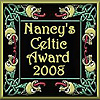
|
|
|
Is Your Shillelagh a Sham?
by Bridget Haggerty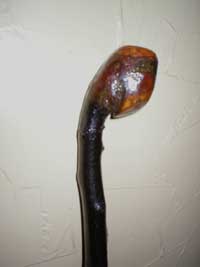
In his very informative book, Things Irish, Anthony Bluett writes that according to a leading folklore authority, the short, stubby blackthorn cudgel sold to tourists as the "ancient Irish shillelagh" has no tradition in Ireland at all.
What I have mistakenly called a shillelagh all these years was once a very popular weapon in 19th-century London. Very handy to have - but not something the Irish would have used at that time, or earlier. Their weapon of choice would have been a cane made from oak, blackthorn, ash or holly.
Known by many names, including bata in Gaelic - which means, fighting stick - the original cane gets its name from the Shillelagh Forest in County Wicklow. The forest was once famous for its massive stands of fine oaks. Sadly, most of them were cut down and exported and, when you see how few trees remain in Ireland, there's little comfort in knowing that many famous buildings in Western Europe were built with Irish imported oak.
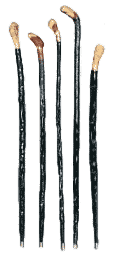 In his wonderful book on Irish folklore, Padraic Colum quotes John Banim in this description of a mansion from his novel The Croppy: "solidly wainscoted with Shillelagh oak against which (as is said of the woodwork of Westminster Hall, also reputed Irish) the venomous spider of England durst not affix his web." In his wonderful book on Irish folklore, Padraic Colum quotes John Banim in this description of a mansion from his novel The Croppy: "solidly wainscoted with Shillelagh oak against which (as is said of the woodwork of Westminster Hall, also reputed Irish) the venomous spider of England durst not affix his web."
Curiously, it was from the pen of an English writer who, on seeing an oak cane and knowing where it came from, coined the term Shillelagh. Eventually, it became synonymous for any Irish walking stick.
Sometimes, the knob on the end was hollowed out and filled with molten lead; this was known as a "loaded stick." However, in sticks made of blackthorn, the knob was actually the root and it would not have been necessary to "load" it because it could pack a significant whack!
The bark is left on for added toughness and often a metal ferrule is secured at the end opposite of the knob. To keep the wood from splitting during the drying process, sticks were often buried in a manure pile, or smeared with butter and placed in the chimney to cure.
 Folklorist Padraic Colum says the shillelagh should not be considered a symbol of Ireland but a badge of honor for those who carried it. When they were very young, Irish boys were exposed to the traditions of the bata, and when they came of age, to carry a stick was viewed as a passage into manhood. Folklorist Padraic Colum says the shillelagh should not be considered a symbol of Ireland but a badge of honor for those who carried it. When they were very young, Irish boys were exposed to the traditions of the bata, and when they came of age, to carry a stick was viewed as a passage into manhood.
Many young Irishmen practiced with the stick regularly because constant sparring was needed to improve their skills. And, while a young man would have been taught by his father to always hold the bata tightly to his chest, so as never to be taken unawares, the finer points of its use would have been learned from the Maighistir Prionnsa or fencing master.
(Russ points out that the use of a 'walking stick' as a weapon carried into the twentieth century. Conan-Doyle made his famous character Sherlock Holmes a master of 'single-stick' fighting.)
 While the stick was carried by Irishmen just about everywhere they went, it was at the fair, wake or pattern (Saint's feast day), that it was most needed. Various groups or factions were always present at most social gatherings and faction fighting was very common until the famines of the 1840s. Most often the factions were members of certain families or of political groups. Sometimes the fights would consist of hundreds of men - and yes, the womenfolk joined in too. They didn't use a bata, but they could make a good account of themselves by wielding a stocking filled with stones. While the stick was carried by Irishmen just about everywhere they went, it was at the fair, wake or pattern (Saint's feast day), that it was most needed. Various groups or factions were always present at most social gatherings and faction fighting was very common until the famines of the 1840s. Most often the factions were members of certain families or of political groups. Sometimes the fights would consist of hundreds of men - and yes, the womenfolk joined in too. They didn't use a bata, but they could make a good account of themselves by wielding a stocking filled with stones.
Some fighters specialized in the use of two sticks. This was called the Troid de bata or two-stick fight. The stick held in the off hand was used as a shield. After the 1840's the factions fights became fewer and farther between; the last recorded one was held at a fair in Co.Tipperary, in 1887.
Fights with the bata were not always of the faction variety; some were sporting events, while others were provoked just for fun. One tradition at a fair was for a man to drag his coat on the ground behind him and throw down the challenge, "Who'll tread on the tail of my coat?", or to ask a crowd, "Who'll say black is the white of my eye?" Often these were friendly, if somewhat rough contests.
The bata was held somewhat towards the lower middle of the stick and was snapped out with the wrist rather than swung like a cudgel. A simple art in terms of technique, it still took years of practice to master. In his 1790 book , Personal Sketches of His Own Times, Sir John Barrington wrote that the stickfights were exhibitions of skill...."like sword exercises and did not appear savage. Nobody was disfigured thereby, or rendered fit for a doctor. I never saw a bone broken or a dangerous contusion from what was called 'whacks' of a shillelagh (which was never too heavy)."
So there you have it - or may be you don't. If you have a bata or walking stick made of oak, ash, holly or blackthorn, you do indeed have a real shillelagh. As for that souvenir you may have picked up at the airport - the short, stubby cudgel which often sports a green bow and a nifty painted shamrock - sorry, it's not a shillelagh, it's a sham!
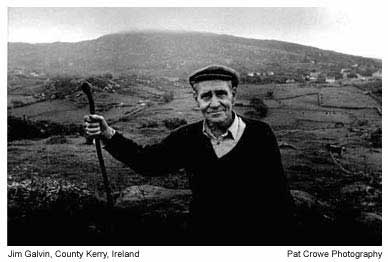
"Oh! an Irishman's heart is as stout as shillelagh, It beats with delight to chase sorrow and woe;
When the piper plays up, then it dances gaily, And thumps with a whack to leather a foe."
ED. NOTE:The blackthorn bush is becoming increasingly more scarce in Ireland, which is why many walking stick suppliers are now sourcing sticks made of this material from Europe. However, one should always keep in mind that it's the tradition and history of the stick that is important and not necessarily what it is made of or where it's from In fact, the original shillelaghs were made of oak and not blackthorn at all.
Resources: A Treasure of Irish Folklore by Padraic Colum. Article by Ken Pfrenger on Walking Equipment.com
Images: Man in a field from a free ecard at IrishAbroad.com
The top photo is Russ' blackthorn walking stick. Note that the head, or knob, is made from the branch the shaft grew from.
The Blackthorn leaning on the wall is from Celtic Expressions.
Any purchase you make helps support our site (and cane wax for Russ' stick - he needs a new ferrule as well). Thank You!
|
|
Thu, Apr 4, 2024
 Ilnacullen, Co. Cork - an Island Garden Ilnacullen, Co. Cork - an Island Garden
Located in the sheltered harbour of Glengarriff in Bantry Bay. Ilnacullin, which means island of holly, is a small island known to horticulturists and lovers of trees and shrubs all around the world as an island garden of rare beauty.
The vivid colours of Rhododendrons and Azaleas reach their peak during May and June, whilst the hundreds of cultivars of climbing plants, herbaceous perennials and choice shrubs dominate the midsummer period from June to August.
Because of its sheltered situation and the warming oceanic influence of the Gulf Stream, the climate is favourable to the growth of ornamental plants from many parts of the world.
Even for those who aren’t particularly interested in gardens, there are many other scenic views, especially in the surrounding waters where seals frequent the rocks on the southern shore.
The cover photo on Bridget's book The Traditional Irish Wedding shows a wrought iron garden gate on Ilnaculen. I took that photo. To see it, go to the home page. It's part of the opening paragraph Failte.
—Russ
Resource: Copy and Image - Cork Guide
Click for More Culture Corner.
Love the aroma of a turf fire? Experience the next best thing with Irish Incense, the peaceful, nostalgic scent that will transport you back in time and place. The perfect gift for Christmas or any other occasion, order now. A special offer for Irish Culture and Customs visitors: 10% discount on all
products! Just enter the Coupon Code ICC200 in the Check out section of
the web site.
Click here for Irish Incense.
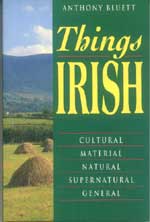
Things Irish
One of our favorite resources. A must-have if you want to learn the basics about Irish culture.
Click here for Things Irish.
We took our time before we watched this one. When we finally did we were amazed. Russ was familiar with the history behind it but not this violent detail. It is excellent but don't let your kids watch it - much too violently graphic. Daniel Day-Lewis is superb as the ultimate villain. Its hard to realise he's the same man who starred in My Left Foot and The Last of the Mohicans
Click here for Gangs of NY.
|
Before you see Martin Scorcese's film 'Gangs Of New York', read John W. Hurley's book. It provides first-hand accounts of Irish gangs and fights, written by a 'reformed' Irish stick-fighter, and vividly describes Ireland's fighting culture which was governed by a code of honour Hurley correctly calls 'Shillelagh Law'. If you are Irish or have an interest in Irish gangs, Irish boxing, the shillelagh, or Scorcese's film, you will really enjoy this book. Adapted from an Amazon review.
Note: Father's Day is June 15
Click here for Stick Fighting.
|
|
|
|
|




 Ilnacullen, Co. Cork - an Island Garden
Ilnacullen, Co. Cork - an Island Garden